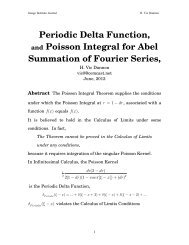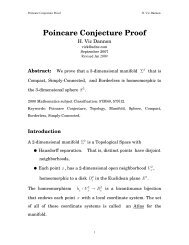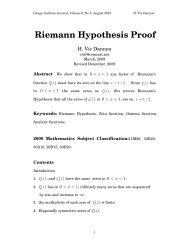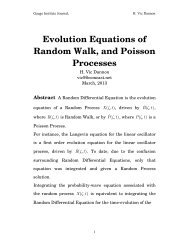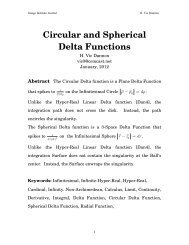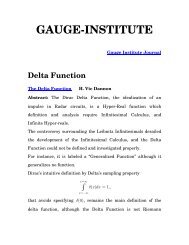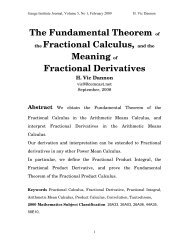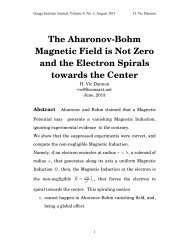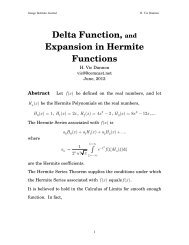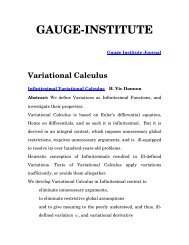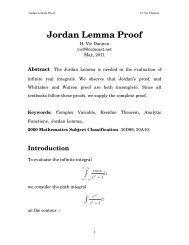Michelson-Morley Experiment and the Aether - Gauge-institute.org
Michelson-Morley Experiment and the Aether - Gauge-institute.org
Michelson-Morley Experiment and the Aether - Gauge-institute.org
You also want an ePaper? Increase the reach of your titles
YUMPU automatically turns print PDFs into web optimized ePapers that Google loves.
The Meaning of <strong>the</strong> <strong>Michelson</strong>-<strong>Morley</strong> <strong>Experiment</strong><br />
H. Vic Dannon<br />
The Meaning of <strong>the</strong><br />
<strong>Michelson</strong>-<strong>Morley</strong><br />
<strong>Experiment</strong><br />
H. Vic Dannon<br />
vic0@comcast.net<br />
April, 2011<br />
Abstract The Null result of <strong>the</strong> <strong>Michelson</strong>-<strong>Morley</strong> experiment,<br />
that ruled out <strong>the</strong> existence of an immobile Ae<strong>the</strong>r, is unexpected<br />
only in terms of Galilean Physics.<br />
In Special Relativity, that Null result is fully expected, <strong>and</strong> does<br />
not rule out <strong>the</strong> existence of any Ae<strong>the</strong>r.<br />
Since textbooks present <strong>the</strong> <strong>Michelson</strong> <strong>Morley</strong> experiment only in<br />
terms of Galilean Physics, its meaning is distorted, <strong>and</strong><br />
misleading.<br />
In particular, <strong>the</strong> <strong>Michelson</strong>-<strong>Morley</strong> <strong>Experiment</strong> cannot, <strong>and</strong> does<br />
not rule out an immobile Ae<strong>the</strong>r, or any Ae<strong>the</strong>r.<br />
Fur<strong>the</strong>rmore, <strong>the</strong> <strong>Michelson</strong> <strong>Morley</strong> experiment is not an anomaly<br />
explained away by Lorentz contraction, but <strong>the</strong> most solid<br />
confirmation for Relativistic Kinematics.<br />
Precision tests of <strong>the</strong> experiment validate fur<strong>the</strong>r <strong>the</strong> formulas of<br />
velocity transformations in Special Relativity, <strong>and</strong> confirm Special<br />
Relativity.<br />
1
The Meaning of <strong>the</strong> <strong>Michelson</strong>-<strong>Morley</strong> <strong>Experiment</strong><br />
H. Vic Dannon<br />
keywords <strong>Michelson</strong>-<strong>Morley</strong>, Interferometer, Ae<strong>the</strong>r, Lorentz<br />
Transformations, Velocity Transformations, Special Relativity,<br />
Galilean Transformations<br />
Physics Astronomy Classification Scheme 03.30.+p<br />
Introduction<br />
Electrodynamics was visualized by analogy with <strong>the</strong> Mechanics of<br />
Fluids. Thus, <strong>the</strong> Ae<strong>the</strong>r, as a medium that permeates <strong>the</strong><br />
universe <strong>and</strong> enables electro-magnetic waves to propagate, was<br />
visualized as water at rest.<br />
The Immobile Ae<strong>the</strong>r Hypo<strong>the</strong>sis contradicts <strong>the</strong> reality of<br />
Molecular Brownian Motion, <strong>and</strong> <strong>the</strong> fact that all matter,<br />
including its sub-particles, participates in some harmonic motion.<br />
A more credible c<strong>and</strong>idate for an Ae<strong>the</strong>r would be <strong>the</strong> Neutrinos,<br />
or <strong>the</strong> photons of Zero Point Energy that permeate <strong>the</strong> universe,<br />
<strong>and</strong> move at light speed, or o<strong>the</strong>r unknown-yet particles.<br />
Never<strong>the</strong>less, <strong>the</strong> <strong>Michelson</strong>-<strong>Morley</strong> <strong>Experiment</strong> was set up to<br />
detect <strong>the</strong> speed of <strong>the</strong> earth, in an immobile Ae<strong>the</strong>r.<br />
The motion of <strong>the</strong> earth in <strong>the</strong> Ae<strong>the</strong>r at speed v generates an<br />
“Ae<strong>the</strong>r wind” with velocity −v .<br />
A light beam that travels time<br />
T 1<br />
, parallel to <strong>the</strong> earth’s motion,<br />
interferes with a light-beam that travels time<br />
<strong>the</strong> motion.<br />
T 2<br />
, perpendicular to<br />
2
The Meaning of <strong>the</strong> <strong>Michelson</strong>-<strong>Morley</strong> <strong>Experiment</strong><br />
H. Vic Dannon<br />
The time-travel difference results in a wave-phase difference, <strong>and</strong><br />
an interference pattern at <strong>the</strong> telescope.<br />
A rotation of <strong>the</strong> Interferometer will shift <strong>the</strong> interference fringes,<br />
by an amount determined by v .<br />
The measured shift indicated<br />
v ≈ 0 , <strong>and</strong> no immobile Ae<strong>the</strong>r.<br />
But <strong>Michelson</strong>-<strong>Morley</strong> estimates for <strong>the</strong> time difference T −T<br />
,<br />
were Galilean.<br />
The speed of <strong>the</strong> beam to <strong>the</strong> mirror M , was taken as c − v<br />
The speed of <strong>the</strong> beam returning from M<br />
1<br />
, was taken as c + v<br />
The Galilean distance in both directions is L 0<br />
,<br />
<strong>and</strong> <strong>the</strong> Galilean time interval is<br />
1<br />
1 2<br />
T<br />
1<br />
L L 2L<br />
1<br />
= + =<br />
c − v c + v c −<br />
0 0 0<br />
1<br />
v<br />
c<br />
2<br />
2<br />
3
The Meaning of <strong>the</strong> <strong>Michelson</strong>-<strong>Morley</strong> <strong>Experiment</strong><br />
H. Vic Dannon<br />
In a right angle triangle where c is <strong>the</strong> hypotenuse, <strong>and</strong> v is one<br />
of <strong>the</strong> sides of <strong>the</strong> triangle, <strong>the</strong> speed of <strong>the</strong> beam to <strong>the</strong> mirror<br />
, <strong>and</strong> back is<br />
M 2<br />
c<br />
2 2<br />
− v ,<br />
<strong>the</strong> Galilean distance in both directions is L 0<br />
,<br />
<strong>and</strong> <strong>the</strong> Galilean time interval is<br />
T<br />
2<br />
L0 L0 2L0<br />
1<br />
= + =<br />
2 2 2 2<br />
c −v c −v<br />
c −<br />
1<br />
v<br />
c<br />
2<br />
2<br />
The Galilean time difference is<br />
T<br />
⎛<br />
⎞<br />
2L<br />
0 1 1<br />
− T = 2 2<br />
c<br />
− ⎜1 v<br />
2 1<br />
v<br />
⎜⎝<br />
− −<br />
2 ⎠⎟<br />
1 2<br />
<strong>and</strong> for v c,<br />
c<br />
2<br />
≈ 2L<br />
2 2<br />
0 v<br />
1 v<br />
L0<br />
v<br />
{(1 ) (1 )<br />
2 2 2 }<br />
c<br />
+ − + = c<br />
c c 2<br />
c<br />
.<br />
c<br />
To explain <strong>the</strong> null result, Lorentz suggested that <strong>the</strong> distance<br />
L 0<br />
contracts in <strong>the</strong> direction of <strong>the</strong> motion by a factor of<br />
Consequently,<br />
2<br />
− .<br />
1<br />
v2<br />
c<br />
T<br />
1<br />
2 2<br />
L0 1−<br />
v<br />
L<br />
2 0<br />
1−<br />
v<br />
2<br />
c<br />
c<br />
2L0<br />
1<br />
= + =<br />
c − v c + v c 1 −<br />
v<br />
c<br />
2<br />
2<br />
,<br />
<strong>and</strong><br />
4
The Meaning of <strong>the</strong> <strong>Michelson</strong>-<strong>Morley</strong> <strong>Experiment</strong><br />
H. Vic Dannon<br />
T<br />
⎛<br />
⎞<br />
2L<br />
0 1 1<br />
− T = 2 2<br />
c<br />
− =<br />
⎜ 1<br />
v<br />
1<br />
v<br />
⎜⎝ − −<br />
2 2 ⎠⎟<br />
1 2<br />
c<br />
c<br />
0.<br />
Feynman [Feynman, I-15-5] notes that<br />
…Although <strong>the</strong> contraction hypo<strong>the</strong>sis successfully accounted<br />
for <strong>the</strong> negative result of <strong>the</strong> experiment, it was open to <strong>the</strong><br />
objection that it was invented for <strong>the</strong> express purpose of<br />
explaining away <strong>the</strong> difficulty, <strong>and</strong> was too artificial…<br />
Indeed, <strong>the</strong> Lorenz contraction alone allows <strong>the</strong> velocities<br />
transformation to be Galilean.<br />
Is it believable that <strong>the</strong> velocities are<br />
c<br />
− v, <strong>and</strong> c + v?<br />
Feynman proceeds to justify <strong>the</strong> null time with arguments<br />
adapted from Einstein’s Special Relativity.<br />
At <strong>the</strong> end, <strong>the</strong> purpose of <strong>the</strong> <strong>Michelson</strong> <strong>Morley</strong> experiment to<br />
establish <strong>the</strong> existence of <strong>the</strong> Ae<strong>the</strong>r is f<strong>org</strong>otten.<br />
The Ae<strong>the</strong>r existence remains unresolved, <strong>and</strong> more precise<br />
<strong>Michelson</strong> <strong>Morley</strong> experiments serve as fur<strong>the</strong>r proof to <strong>the</strong> nonexistence<br />
of <strong>the</strong> Ae<strong>the</strong>r.<br />
The significance of <strong>the</strong> experiment to <strong>the</strong> confirmation of<br />
relativistic kinematics, <strong>and</strong> special relativity goes unnoticed in <strong>the</strong><br />
Textbooks.<br />
The most solid experimental confirmation of Special Relativity is<br />
not presented as such.<br />
5
The Meaning of <strong>the</strong> <strong>Michelson</strong>-<strong>Morley</strong> <strong>Experiment</strong><br />
H. Vic Dannon<br />
Our purpose here is to elucidate <strong>and</strong> clarify <strong>the</strong> meaning of <strong>the</strong><br />
<strong>Michelson</strong> <strong>Morley</strong> experiment.<br />
By casting <strong>the</strong> experiment in terms of special relativity, we aim to<br />
establish that<br />
<strong>Michelson</strong>-<strong>Morley</strong> <strong>Experiment</strong> cannot, <strong>and</strong> does not rule out<br />
an immobile Ae<strong>the</strong>r, or any Ae<strong>the</strong>r.<br />
<strong>the</strong> <strong>Michelson</strong> <strong>Morley</strong> <strong>Experiment</strong> validates <strong>the</strong> formulas of<br />
velocity transformations in Special Relativity, <strong>and</strong> confirms<br />
Special Relativity.<br />
Any greater precision in <strong>the</strong> null result of <strong>the</strong> experiment,<br />
puts Special Relativity on a firmer basis.<br />
We proceed to set up <strong>the</strong> <strong>Michelson</strong>-<strong>Morley</strong> <strong>Experiment</strong> in Lorentz<br />
Coordinate Transformations terms.<br />
6
The Meaning of <strong>the</strong> <strong>Michelson</strong>-<strong>Morley</strong> <strong>Experiment</strong><br />
H. Vic Dannon<br />
1.<br />
<strong>Michelson</strong>-<strong>Morley</strong> in Special Relativity<br />
In <strong>the</strong> interferometer system S ' ,<br />
<strong>the</strong> speed of <strong>the</strong> Ae<strong>the</strong>r wind is −v .<br />
The speed of <strong>the</strong> beam to <strong>the</strong> mirror<br />
M 1<br />
is<br />
'<br />
ux<br />
= c.<br />
Thus, <strong>the</strong> speed of <strong>the</strong> beam to <strong>the</strong> mirror<br />
system S is<br />
u<br />
=<br />
c − v<br />
= c.<br />
1 +<br />
x c( −v)<br />
c<br />
2<br />
M 1<br />
in <strong>the</strong> observer<br />
The distance traveled to<br />
M 1<br />
in <strong>the</strong> observer system S is<br />
L v t<br />
0<br />
− Δ '<br />
1 −<br />
v<br />
c<br />
2<br />
2<br />
Therefore, <strong>the</strong> beam travel-time to<br />
M 1<br />
in <strong>the</strong> observer system S is<br />
L v t<br />
0<br />
− Δ '<br />
c<br />
1 −<br />
v<br />
c<br />
The speed of <strong>the</strong> beam returning from <strong>the</strong> mirror<br />
'<br />
ux<br />
2<br />
2<br />
=− c.<br />
M 1<br />
is<br />
Thus, <strong>the</strong> speed of <strong>the</strong> beam returning from <strong>the</strong> mirror<br />
observer system S is<br />
M 1<br />
in <strong>the</strong><br />
7
The Meaning of <strong>the</strong> <strong>Michelson</strong>-<strong>Morley</strong> <strong>Experiment</strong><br />
H. Vic Dannon<br />
u<br />
=<br />
−c<br />
−v<br />
=<br />
1 +<br />
x ( −c)( −v)<br />
c<br />
2<br />
− c.<br />
The distance traveled from<br />
M 1<br />
in <strong>the</strong> observer system S is<br />
−L v t<br />
0<br />
− Δ '<br />
1 −<br />
v<br />
c<br />
Therefore, <strong>the</strong> beam travel-time return from<br />
system S is<br />
2<br />
2<br />
L v t<br />
0<br />
+ Δ '<br />
c<br />
1 −<br />
v<br />
c<br />
2<br />
2<br />
M 1<br />
in <strong>the</strong> observer<br />
Consequently, <strong>the</strong> beam time interval to go to<br />
M 1<br />
, <strong>and</strong> return<br />
from<br />
M 1<br />
, in <strong>the</strong> observer system S is<br />
T<br />
1<br />
L0 −vΔ<br />
t'<br />
L0<br />
+ vΔt'<br />
= +<br />
2 2<br />
c 1−<br />
v<br />
c 1−<br />
v<br />
c<br />
2 2<br />
c<br />
=<br />
2L<br />
1<br />
c<br />
0<br />
1 −<br />
v<br />
c<br />
2<br />
2<br />
.<br />
Therefore, according to Special Relativity, <strong>Michelson</strong>-<strong>Morley</strong>’s<br />
2L0<br />
1<br />
Galilean time interval ,<br />
2<br />
c −<br />
1<br />
v<br />
c<br />
2<br />
, is incorrect.<br />
Regarding <strong>the</strong> path to <strong>the</strong> 2 nd<br />
mirror , <strong>the</strong> speed of <strong>the</strong> beam to<br />
<strong>the</strong> mirror<br />
M 2<br />
is<br />
'<br />
uy<br />
= c.<br />
8
The Meaning of <strong>the</strong> <strong>Michelson</strong>-<strong>Morley</strong> <strong>Experiment</strong><br />
H. Vic Dannon<br />
Thus, <strong>the</strong> speed of <strong>the</strong> beam to <strong>the</strong> mirror<br />
system S is<br />
M 2<br />
in <strong>the</strong> observer<br />
u<br />
c<br />
2<br />
= 1 − = c<br />
2<br />
1 +<br />
v<br />
y c( −v)<br />
c<br />
c<br />
2<br />
2 2<br />
c − v .<br />
c − v<br />
The distance traveled to<br />
M2<br />
in <strong>the</strong> observer system S is L0<br />
Therefore, <strong>the</strong> beam travel-time to<br />
M 2<br />
in <strong>the</strong> observer system S is<br />
L0<br />
( c − v )<br />
2 2<br />
c c − v<br />
The speed of <strong>the</strong> beam returning from <strong>the</strong> mirror<br />
'<br />
uy<br />
=− c.<br />
M 2<br />
is<br />
Thus, <strong>the</strong> speed of <strong>the</strong> beam returning from <strong>the</strong> mirror<br />
observer system S is<br />
M 2<br />
in <strong>the</strong><br />
u<br />
−c<br />
2<br />
= 1 − = −c<br />
2<br />
1 +<br />
v<br />
y ( −c)( −v)<br />
c<br />
c<br />
2<br />
2 2<br />
c −v .<br />
c + v<br />
The distance traveled from<br />
M2<br />
in <strong>the</strong> observer system S is −L0<br />
Therefore, <strong>the</strong> beam travel-time from<br />
M 2<br />
in <strong>the</strong> observer system<br />
S is<br />
L0<br />
( c + v )<br />
2 2<br />
c c − v<br />
Consequently, <strong>the</strong> beam time interval to go to<br />
M 2<br />
, <strong>and</strong> return<br />
from<br />
M 2<br />
, in <strong>the</strong> observer system S is<br />
9
The Meaning of <strong>the</strong> <strong>Michelson</strong>-<strong>Morley</strong> <strong>Experiment</strong><br />
H. Vic Dannon<br />
L0 L0<br />
T2<br />
= ( c − v) + ( c + v)<br />
2 2 2 2<br />
c c −v c c −v<br />
=<br />
c<br />
2L<br />
0<br />
1 −<br />
v<br />
c<br />
2<br />
2<br />
.<br />
Therefore, according to Special Relativity, <strong>Michelson</strong>-<strong>Morley</strong>’s<br />
Galilean time interval<br />
2L<br />
1<br />
c<br />
0<br />
1 −<br />
v<br />
c<br />
2<br />
2<br />
is correct.<br />
Finally, <strong>the</strong> time difference in special relativity is<br />
T<br />
⎛<br />
⎞<br />
2L<br />
0 1 1<br />
− T = 2 2<br />
c<br />
− =<br />
⎜ 1<br />
v<br />
1<br />
v<br />
⎜⎝ − −<br />
2 2 ⎠⎟<br />
1 2<br />
c<br />
c<br />
0<br />
In conclusion, in special relativity, <strong>the</strong> time difference does not<br />
depend on <strong>the</strong> speed of <strong>the</strong> Ae<strong>the</strong>r wind, <strong>and</strong> no shift should be<br />
expected.<br />
Thus, <strong>the</strong> null results of <strong>the</strong> <strong>Michelson</strong>-<strong>Morley</strong> experiment<br />
validate Relativistic kinematics, <strong>and</strong> confirm Special Relativity.<br />
In particular, <strong>the</strong> <strong>Michelson</strong>-<strong>Morley</strong> <strong>Experiment</strong> does not rule out<br />
immobile Ae<strong>the</strong>r, or any Ae<strong>the</strong>r.<br />
References<br />
Benson, Harris, “University Physics”, Wiley, 1991<br />
Feynman, “Lectures of physics”, Volume I, section 15, Addison-Wesley, 1963.<br />
Woan, Graham, “The Cambridge H<strong>and</strong>book of Physics Formulas”, Cambridge<br />
University Press, 2000.<br />
10



